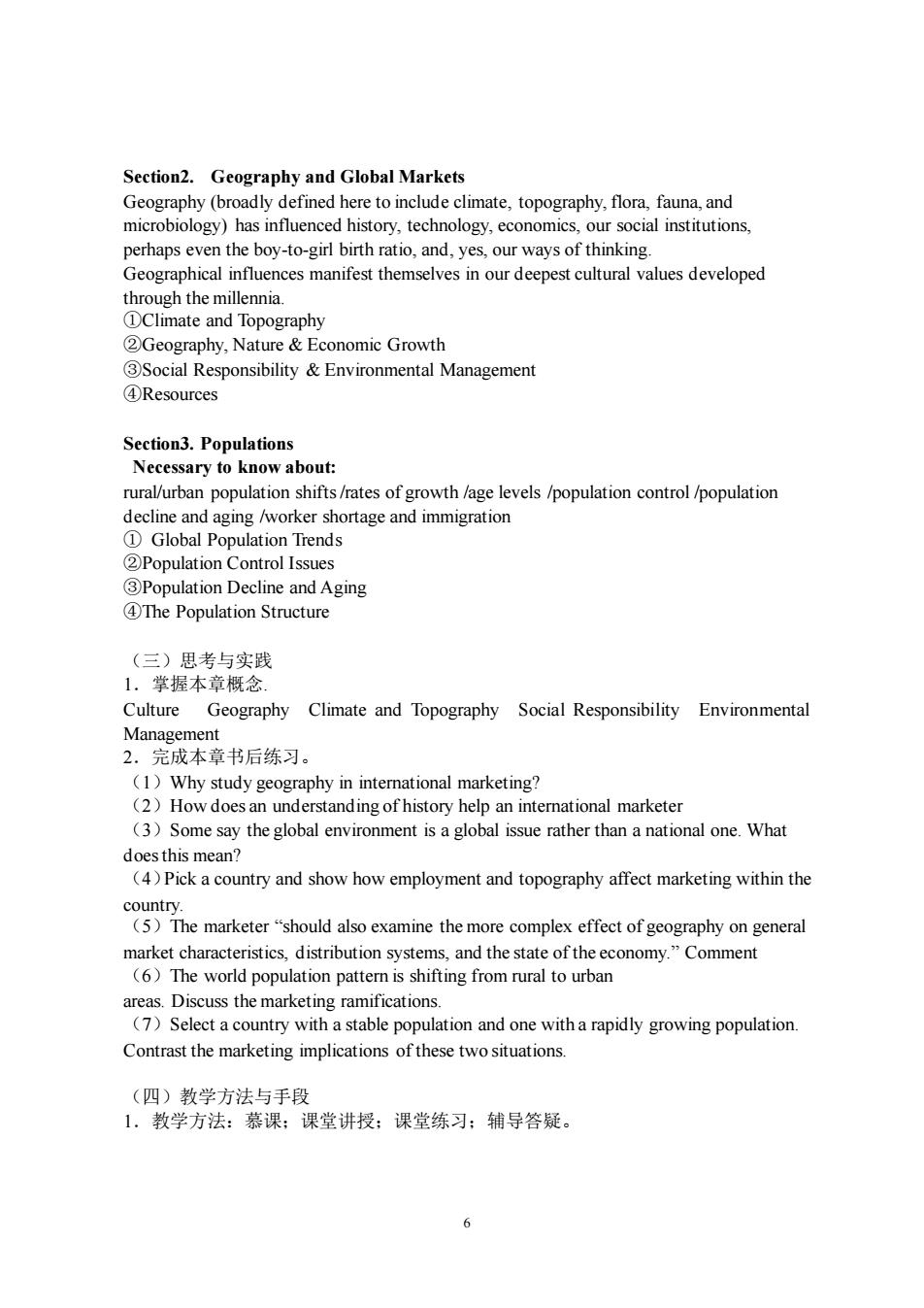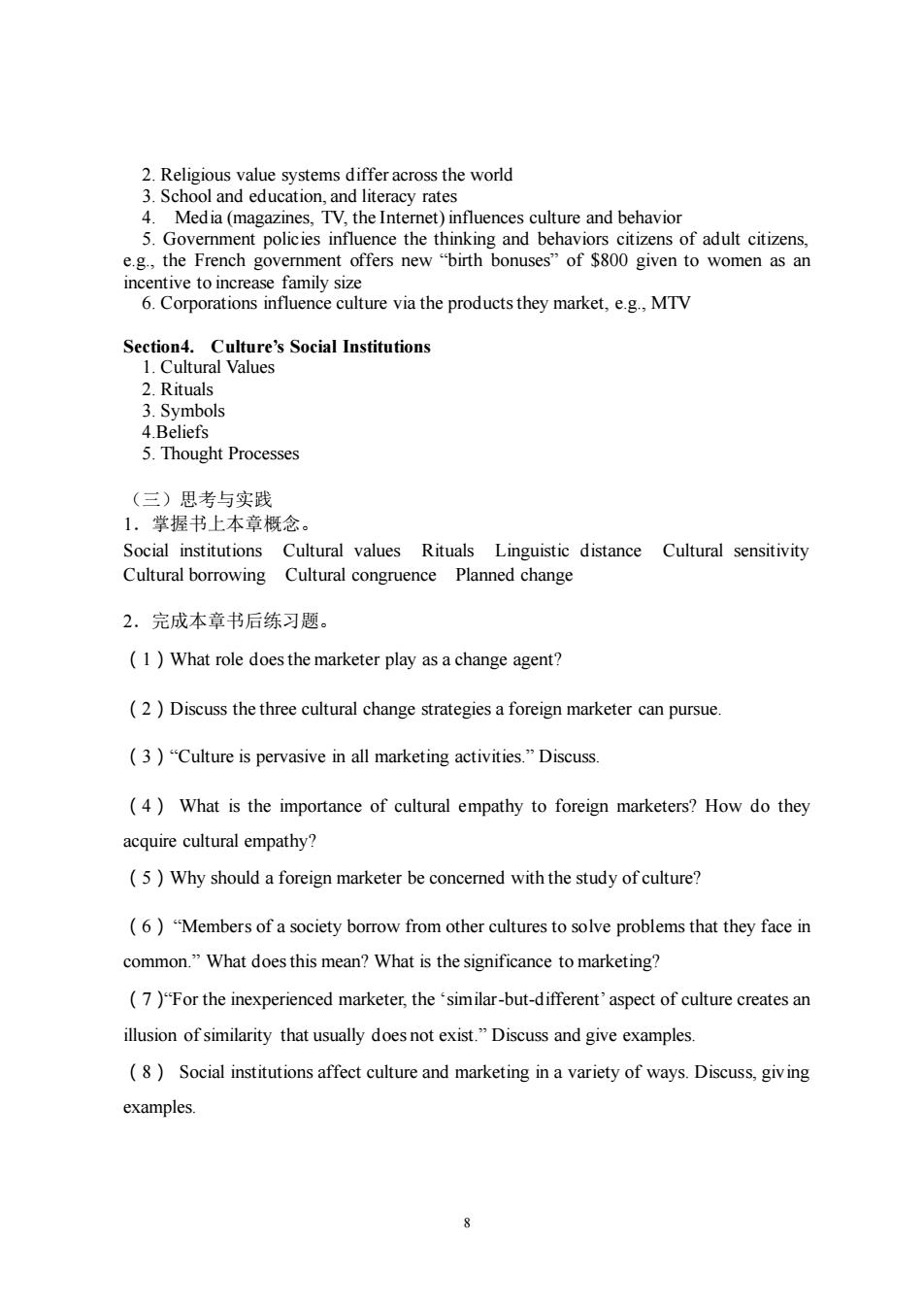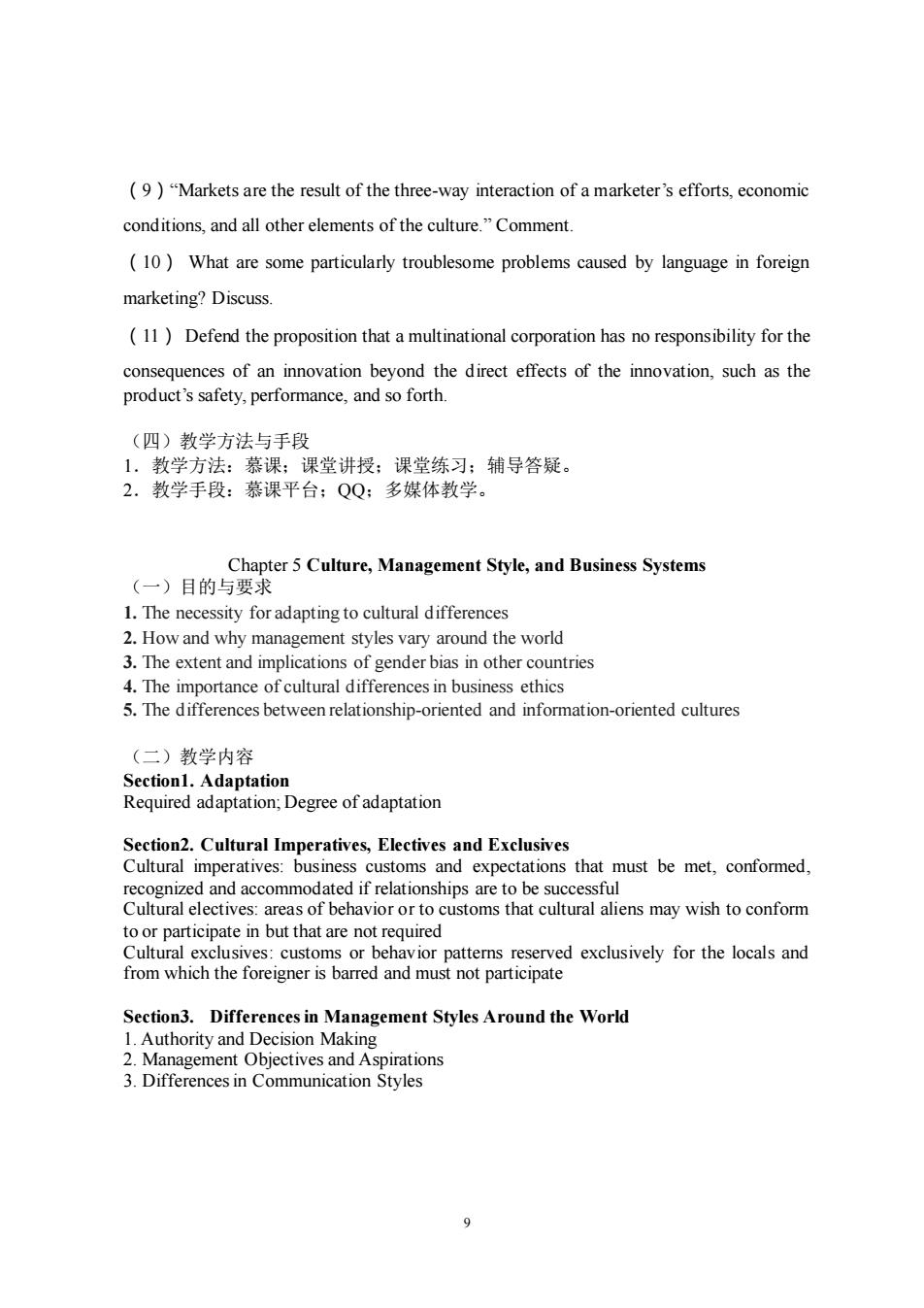
Section2.Geography and Global Markets Geography (broadly defined here to include climate,topography,flora,fauna,and microbiology)has influenced history,technology,economics,our social institutions. en the boy-to-girl birth ratio,and,yes,our ways of thinking influences manifest themselves in our deepest cultural alues developed through the millennia. (Climate and Topography 2Geography,Nature Economic Growth Social Responsibility&Environmental Management ④Resources Section3.Populations Necessary to know about: rural/urban population shifts /rates of growth /age levels /population control /population aging /wo ortage and immigration 2Population Control Issues 3Population Decline and Aging 4The Population Structure 二)甲老与空 掌握本章概念 Culture Geography Climate and Topography Social Responsibility Environmental Management 2.完成本章书后练习。 ational marketing? (3)Some say the global environment is a global issue rather than a national one.What doesthis mean? (4)Pick a country and show how employment and topography affect marketing within the market characteristics,distribution systems,and the state of the economy."Comment (6)The world population pattern is shifting from rural to urban areas.Discuss the marketing ramifications. (7Select a country with a stable population and one witha rapidly growing population Contrast the marketing implications of these two situations (四)教学方法与手段 1.教学方法:慕课:课堂讲授:课堂练习:辅导答疑。 6
6 Section2. Geography and Global Markets Geography (broadly defined here to include climate, topography, flora, fauna, and microbiology) has influenced history, technology, economics, our social institutions, perhaps even the boy-to-girl birth ratio, and, yes, our ways of thinking. Geographical influences manifest themselves in our deepest cultural values developed through the millennia. ①Climate and Topography ②Geography, Nature & Economic Growth ③Social Responsibility & Environmental Management ④Resources Section3. Populations Necessary to know about: rural/urban population shifts /rates of growth /age levels /population control /population decline and aging /worker shortage and immigration ① Global Population Trends ②Population Control Issues ③Population Decline and Aging ④The Population Structure (三)思考与实践 1.掌握本章概念. Culture Geography Climate and Topography Social Responsibility Environmental Management 2.完成本章书后练习。 (1)Why study geography in international marketing? (2)How does an understanding of history help an international marketer (3)Some say the global environment is a global issue rather than a national one. What does this mean? (4)Pick a country and show how employment and topography affect marketing within the country. (5)The marketer “should also examine the more complex effect of geography on general market characteristics, distribution systems, and the state of the economy.” Comment (6)The world population pattern is shifting from rural to urban areas. Discuss the marketing ramifications. (7)Select a country with a stable population and one with a rapidly growing population. Contrast the marketing implications of these two situations. (四)教学方法与手段 1.教学方法:慕课;课堂讲授;课堂练习;辅导答疑

2.教学手段:慕课平台:QQ:多媒体教学。 Chapter 4 Cultural Dynamics in Assessing Global Markets (一)目的与要求 The origins of cul nd its consequences (二)教学内容 Section1.A CASE EQUITIES AND Ebay-CULTURE GETS IN THE WAY Section2.Culture's Pervasive Impac es or d influences culture Italy.Even diseases are influe ed h pre sto f by British,wines by France and ach r in 1 nd lu an in Exhibit 4.2 Patterns of Consumption(annual per capita) and Dried Country (ka Wine (S) Tobacco (S ance 021 370 228 438 Netherlands 153610 4.8 38 490 50 43 3.1 305 Discussion:Why there are no Starbucks in Italy? Section3. Culture's Social Institutions Social institu including family,religion,school,the media,government,and corporations all ct culture and vility are interpreted erythhoidefne deceney ,0 1.Family behavior varies across the world
7 2.教学手段:慕课平台;QQ;多媒体教学。 Chapter 4 Cultural Dynamics in Assessing Global Markets (一)目的与要求 1. The importance of culture to an international marketer 2. The origins of culture 3. The elements of culture 4. The impact of cultural borrowing 5. The strategy of planned change and its consequences (二)教学内容 Section1. A CASE EQUITIES AND Ebay –CULTURE GETS IN THE WAY Section2. Culture’s Pervasive Impact Consumption of different types of food influences culture Chocolate by Swiss, seafood by Japanese preference, beef by British, wines by France and Italy,Even diseases are influenced by culture stomach cancer in Japan, and lung cancer in Spain Discussion: Why there are no Starbucks in Italy? Section3. Culture’s Social Institutions Social institutions including family, religion, school, the media, government, and corporations all affect culture The family, social classes, group behavior, age groups, and how societies define decency and civility are interpreted differently within every culture 1. Family behavior varies across the world

acy late Media(magazin the I fluences . lture and behavior ofadultcizens eg. the F of $800 given to women as a .Coporations nfuenecure via the products they market,MTV Section4.Culture's Social Institutions 1.Cultural Values 2.Rituals 3.Symbols 4.Beliefs 5.Thought Processes (三)思考与实践 1.掌握书上本章概念。 Social institutions Cultural values Rituals Linguistic distance Cultural sensitivity Cultural borrowing Cultural congruence Planned change 2.完成本章书后练习题。 (1 )What role does the marketer play as a change agent? (2)Discuss the three cultural change strategies a foreign marketer can pursue. (3)"Culture is pervasive in all marketing activities."Discuss. (4)What is the importance of cultural empathy to foreign marketers?How do they acquire cultural empathy? (5 )Why should a foreign marketer be concerned with the study of culture? (6)"Members of a society borrow from other cultures tosolve problems that they face in common."What does this mean?What is the significance to marketing? (7)"For the inexperienced marketer,thesimilar-but-different'aspect of culture creates an illusion of similarity that usually doesnot exist."Discuss and give examples (8)Social institutions affect culture and marketing in a variety of ways.Discuss,giving examples
8 2. Religious value systems differ across the world 3. School and education, and literacy rates 4. Media (magazines, TV, the Internet) influences culture and behavior 5. Government policies influence the thinking and behaviors citizens of adult citizens, e.g., the French government offers new “birth bonuses” of $800 given to women as an incentive to increase family size 6. Corporations influence culture via the products they market, e.g., MTV Section4. Culture’s Social Institutions 1. Cultural Values 2. Rituals 3. Symbols 4.Beliefs 5. Thought Processes (三)思考与实践 1.掌握书上本章概念。 Social institutions Cultural values Rituals Linguistic distance Cultural sensitivity Cultural borrowing Cultural congruence Planned change 2.完成本章书后练习题。 (1)What role does the marketer play as a change agent? (2)Discuss the three cultural change strategies a foreign marketer can pursue. (3)“Culture is pervasive in all marketing activities.” Discuss. (4) What is the importance of cultural empathy to foreign marketers? How do they acquire cultural empathy? (5)Why should a foreign marketer be concerned with the study of culture? (6) “Members of a society borrow from other cultures to solve problems that they face in common.” What does this mean? What is the significance to marketing? (7)“For the inexperienced marketer, the ‘similar-but-different’ aspect of culture creates an illusion of similarity that usually does not exist.” Discuss and give examples. (8) Social institutions affect culture and marketing in a variety of ways. Discuss, giving examples

(9)"Markets are the result of the three-way interaction of a marketer's efforts,economic conditions,and all other elements of the culture."Comment. (10)What are some particularly troublesome problems caused by language in foreign marketing?Discuss. (11)Defend the proposition that a multinational corporation has no responsibility for the product's safety,performance,and so forth (四)教学方法与手段 1.教学方法:慕课:课堂讲授:课堂练习:辅导答疑。 2.教学手段:慕课平台:QQ:多媒体教学。 Chapter 5 Culture,Management Style,and Business Systems (一)目的与要求 1.The necessity for adapting to cultural differences 2.How and why agement styles vary around the world 3.The extent and implications of gender bias in other countries 4.The importance of cultural differences in business ethics 5.The differences between relationship-oriented and information-oriented cultures (二)教学内容 Sectionl.Ada Required adaptation:Degree of adaptation Section2.Cultural Imperatives,Electives and Exclusives Cultural imperatives:business customs and expectations that must be met,conformed, recognized and accommodated if relationships are to be successful Cultural electives:areas of behavior or to customs that cultural aliens may wish to conform to or participate in but that are not required Cultural exclusives:customs or beh avior patterns reserved exclusively for the locals and from which the foreigner is barred and must not participate Section3.Differences in Management Styles Around the Workd Authority and ion Ma
9 (9)“Markets are the result of the three-way interaction of a marketer’s efforts, economic conditions, and all other elements of the culture.” Comment. (10) What are some particularly troublesome problems caused by language in foreign marketing? Discuss. (11) Defend the proposition that a multinational corporation has no responsibility for the consequences of an innovation beyond the direct effects of the innovation, such as the product’s safety, performance, and so forth. (四)教学方法与手段 1.教学方法:慕课;课堂讲授;课堂练习;辅导答疑。 2.教学手段:慕课平台;QQ;多媒体教学。 Chapter 5 Culture, Management Style, and Business Systems (一)目的与要求 1. The necessity for adapting to cultural differences 2. How and why management styles vary around the world 3. The extent and implications of gender bias in other countries 4. The importance of cultural differences in business ethics 5. The differences between relationship-oriented and information-oriented cultures (二)教学内容 Section1. Adaptation Required adaptation; Degree of adaptation Section2. Cultural Imperatives, Electives and Exclusives Cultural imperatives: business customs and expectations that must be met, conformed, recognized and accommodated if relationships are to be successful Cultural electives: areas of behavior or to customs that cultural aliens may wish to conform to or participate in but that are not required Cultural exclusives: customs or behavior patterns reserved exclusively for the locals and from which the foreigner is barred and must not participate Section3. Differences in Management Styles Around the World 1. Authority and Decision Making 2. Management Objectives and Aspirations 3. Differences in Communication Styles

Exhibit 5.2 kground of Latin Americar English (UK) French North American(US) Scandinavian erman Eopia P-Time M-Tim Section4.Gender Bias Section 5.Business Ethics (1)Utilitariar ethics nd.who are the peru (2)Rights of the parties Doseggee (3)Justice or fairness (三)思考与实践 1.掌握书上本章概念 Cultural imperative:Cultural elective:Cultural exclusive:Silent languages:Monochronic time(M-time);Polychronic time(P-time);Bribery;Lubrication;Subornation 2.完成本章书后练习题。 (1)"More than tolerance of an alien culture is required;there is a need for affirmative 10
10 4. Formality and Tempo 5. P-Time versus M-Time 6. Negotiations Emphasis 7. Market Orientation Section4. Gender Bias Section 5. Business Ethics (三)思考与实践 1.掌握书上本章概念。 Cultural imperative; Cultural elective; Cultural exclusive; Silent languages; Monochronic time (M-time); Polychronic time (P-time); Bribery; Lubrication; Subornation 2.完成本章书后练习题。 (1) “More than tolerance of an alien culture is required; there is a need for affirmative